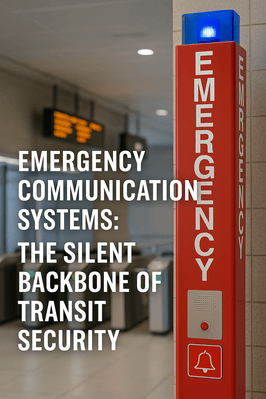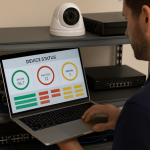
When people think about transportation security, they usually picture surveillance cameras, access gates, and uniformed personnel. But what often gets overlooked is the critical system working quietly in the background—the emergency communication system (ECS). In a crisis, it's the difference between confusion and coordination, between chaos and calm.
For transit agencies, airport operators, and fleet managers, ECS is more than a compliance checkbox—it’s a frontline tool that saves lives, reduces response times, and keeps operations running under pressure.
k
k
📢 What Is an Emergency Communication System?
An emergency communication system is a connected platform that enables rapid and reliable communication during critical incidents—whether that’s a medical emergency, fire, equipment failure, active threat, or severe weather.
In a transportation setting, ECS often includes:
-
Emergency call boxes / panic stations
-
Mass notification systems (text, PA, visual alerts)
-
Two-way intercoms
-
Digital signage
-
Remote lockdown activation
-
Integration with video surveillance and access control systems
The goal? Clear, fast communication with the right people, in the right place, at the right time.
k
k
🚆 Why ECS Is Vital for Transit Security
Transit systems operate in complex, high-traffic environments where seconds count. Passengers, staff, and contractors are constantly on the move, and facilities like terminals, depots, and platforms are vulnerable to unexpected threats.
A robust ECS supports transit security by:
✅ Reducing Response Time
When an emergency occurs, the ECS acts as the first line of communication. With direct calls to security personnel or dispatchers, staff can initiate response protocols instantly—long before help arrives.
✅ Coordinating Across Teams and Sites
Whether you manage one facility or a network of depots and terminals, ECS unifies emergency communication. Everyone gets the same critical information at the same time—improving coordination between security, operations, and first responders.
✅ Guiding the Public During Emergencies
Loudspeaker alerts, LED signage, or mobile texts can guide passengers and staff to safety, reducing panic and confusion. Whether it’s a fire drill or an active shooter scenario, timely direction saves lives.
✅ Protecting Workers in Isolated Zones
Many transit workers—bus drivers, overnight maintenance staff, rail yard personnel—operate in isolated areas. Emergency stations and mobile alert buttons give them a lifeline in the event of danger or injury.
k
k
🔄 ECS in Action: Real-World Use Cases
Let’s break down a few practical examples of how ECS is the backbone of daily security operations:
🚨 Case 1: Medical Emergency on a Train Platform
A passenger collapses. A nearby emergency intercom allows a bystander to alert staff within seconds. Medical help is dispatched, announcements are made over the PA to redirect foot traffic, and video feeds from the area help guide paramedics to the exact location.
🔒 Case 2: Suspicious Package at a Bus Terminal
Security receives a call via a panic station. Access control locks down surrounding doors while messages on overhead signage reroute passengers. Surveillance confirms the nature of the threat, and ECS keeps both staff and the public informed until resolution.
🌪 Case 3: Severe Weather Alert
With an integrated mass notification system, all personnel and passengers receive simultaneous alerts via mobile devices, PA systems, and visual signage. ECS coordinates building lockdowns while rerouting transit lines away from the affected area.
k
k
🧠 Key Features to Look for in a Transit ECS
If you're evaluating or upgrading your emergency communication system, here are some must-have features:
-
Two-way communication for real-time interaction
-
Automated alerts triggered by sensors or alarms
-
Multi-channel notifications (audio, visual, mobile)
-
Zone-specific messaging to avoid over-alerting unaffected areas
-
System redundancy for power or network outages
-
Integration with video surveillance and access control for coordinated response
k
k
🛡️ How SSP Designs Emergency Communication for Transit Systems
At SSP, we work with transit agencies, airports, and logistics centers to design ECS that meet the unique demands of each facility. Our systems are built to:
-
Operate 24/7/365 under pressure
-
Provide centralized command and control
-
Integrate with your existing security infrastructure
-
Ensure compliance with transportation and safety regulations
Because in the moments that matter most, silence is not an option.
k
k
📞 Ready to Strengthen Your Emergency Response?
Don’t wait for a crisis to test your communication. Whether you manage a single site or a regional transit system, SSP can help implement an emergency communication solution that’s fast, flexible, and fail-safe.
👉 Discover how SSP keeps transportation systems secure and operational.


